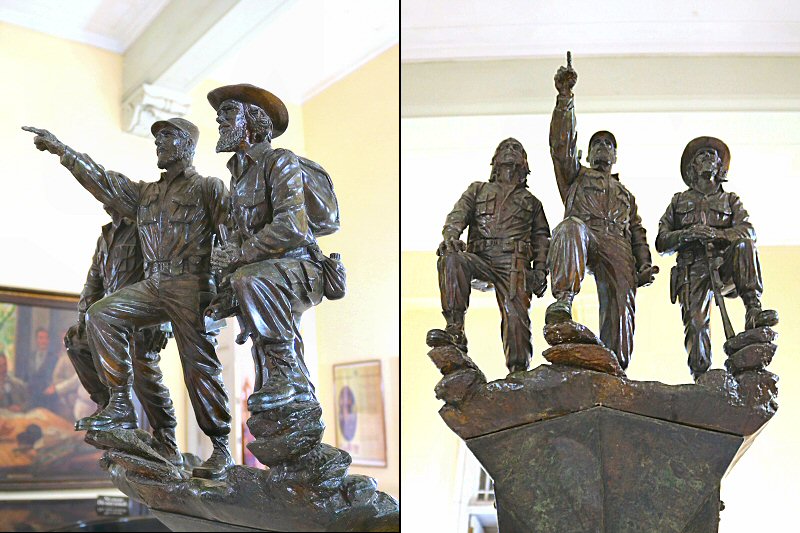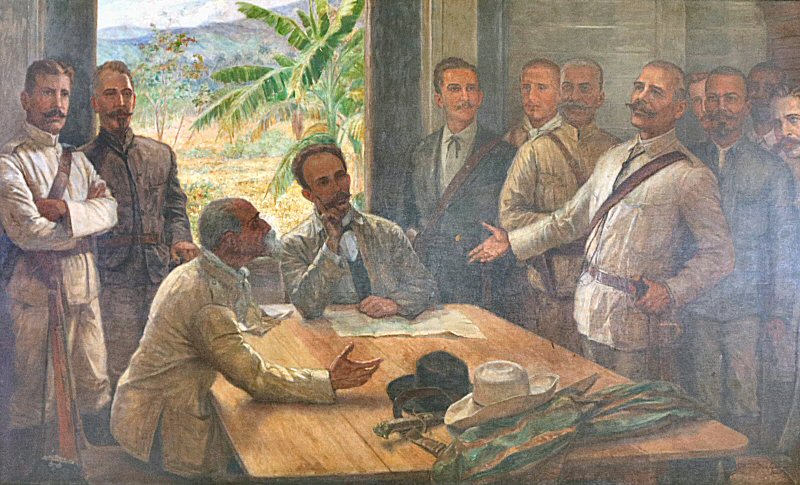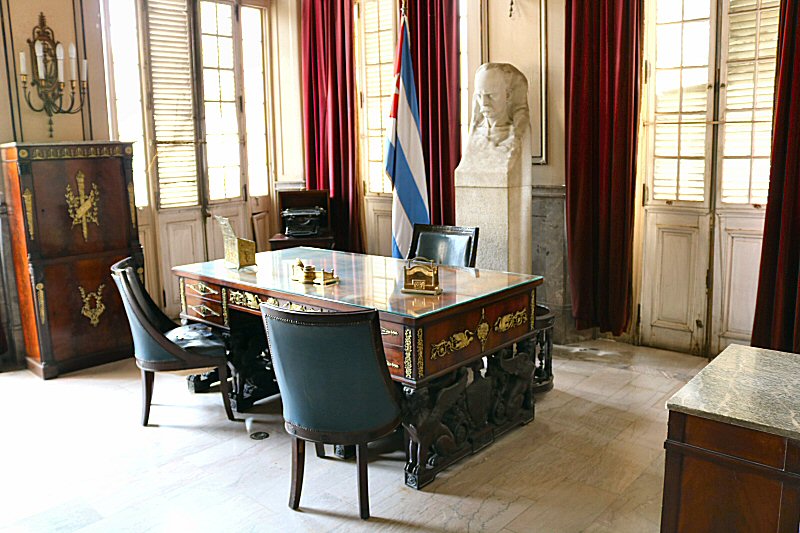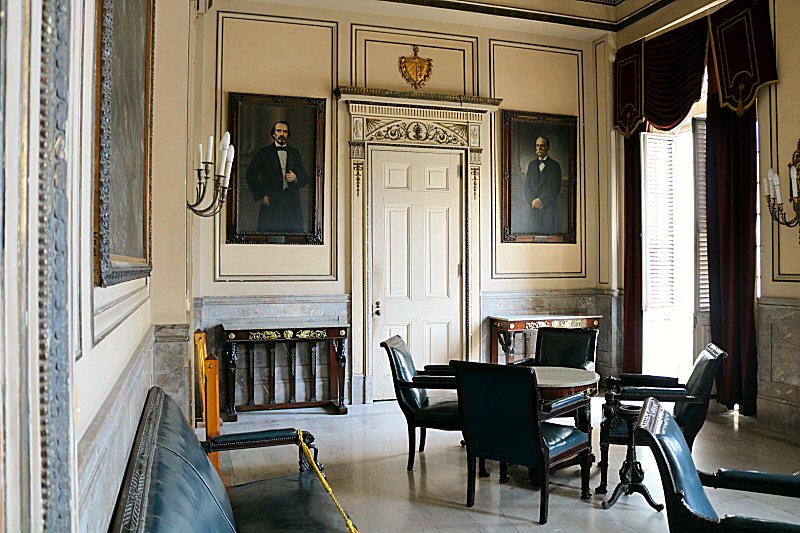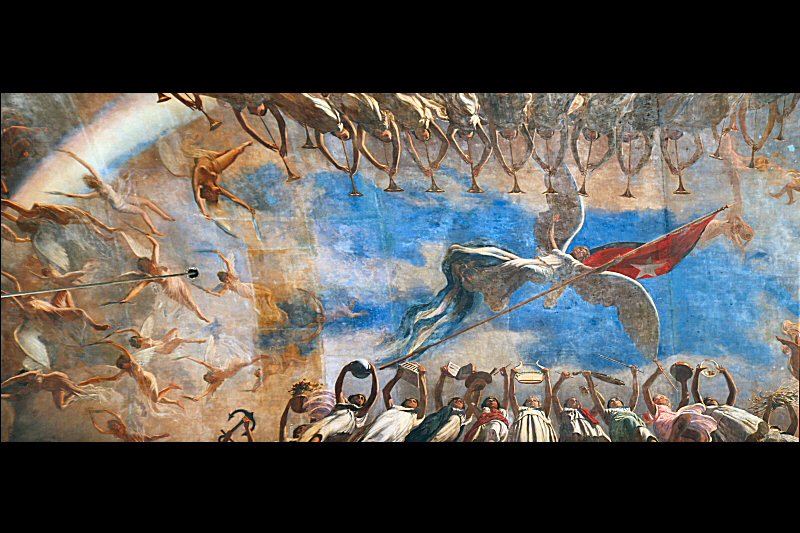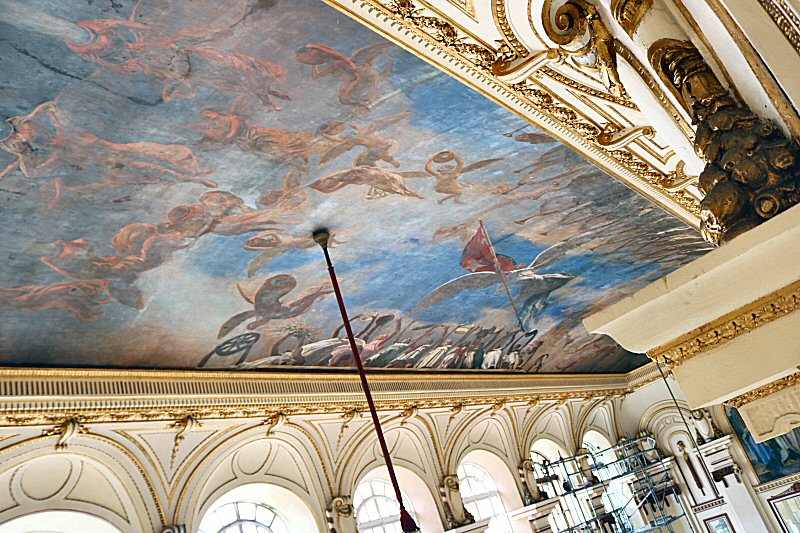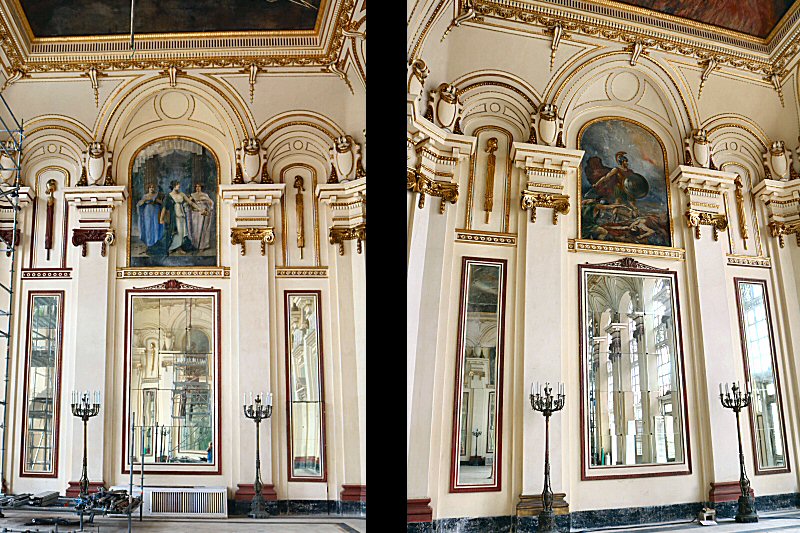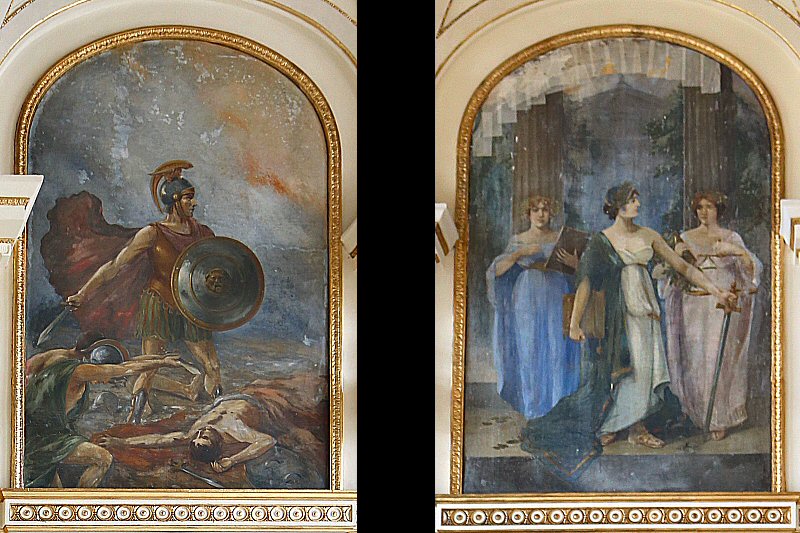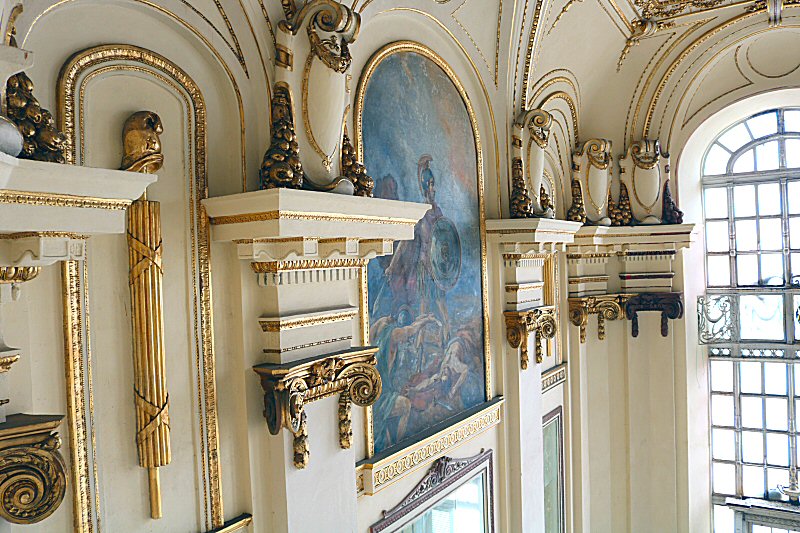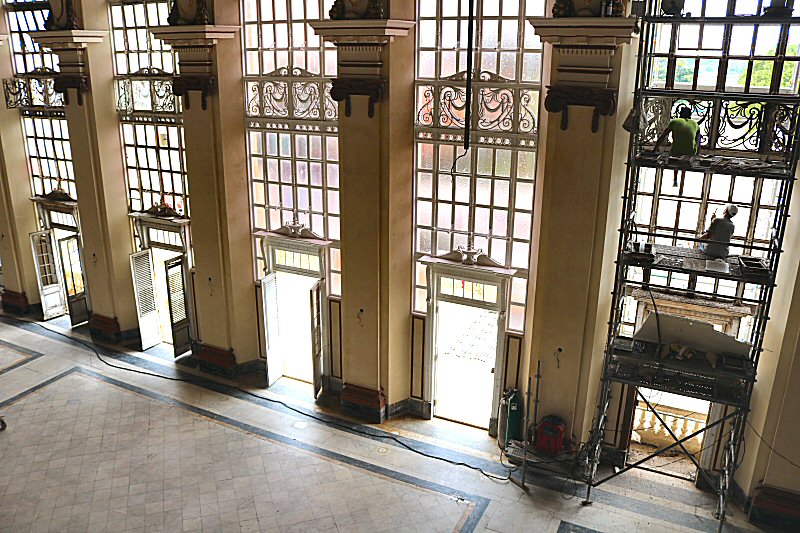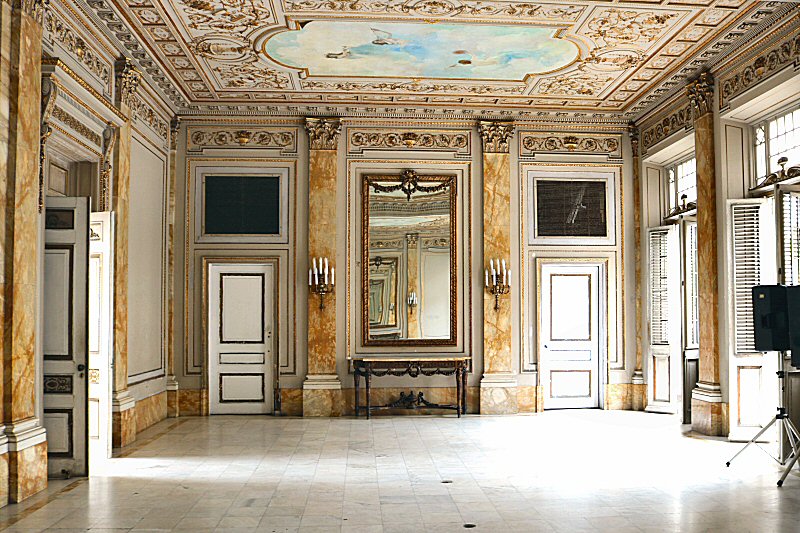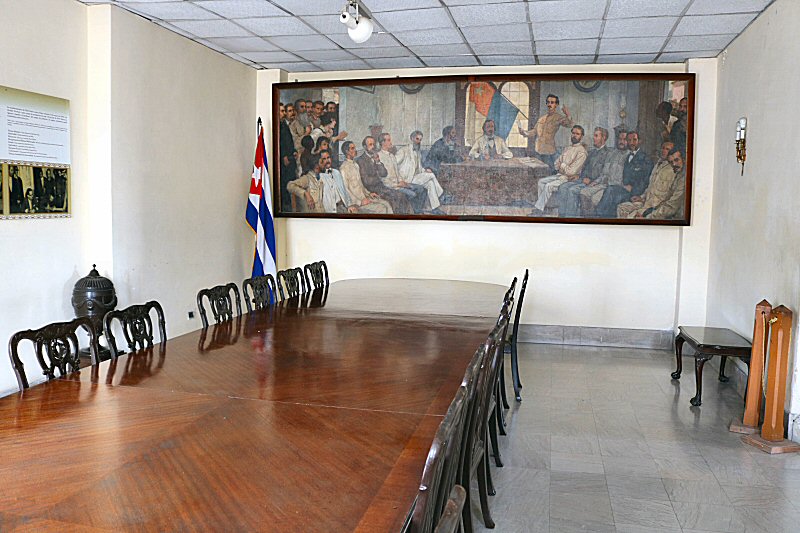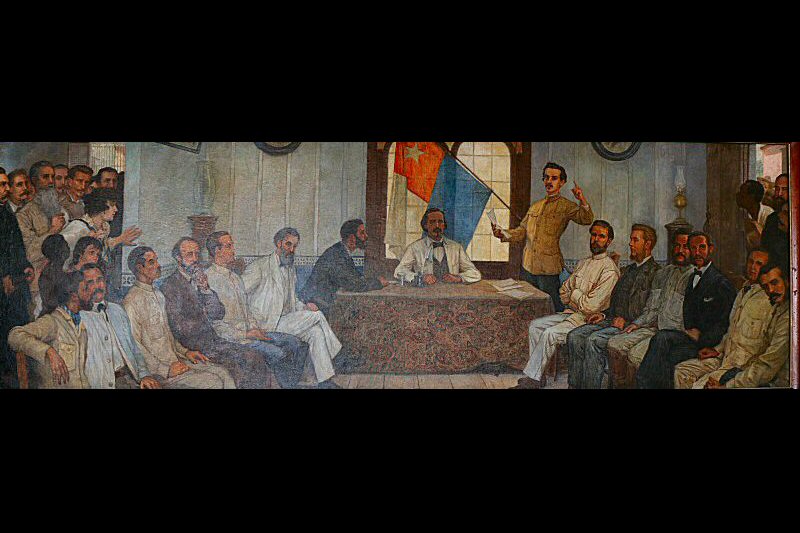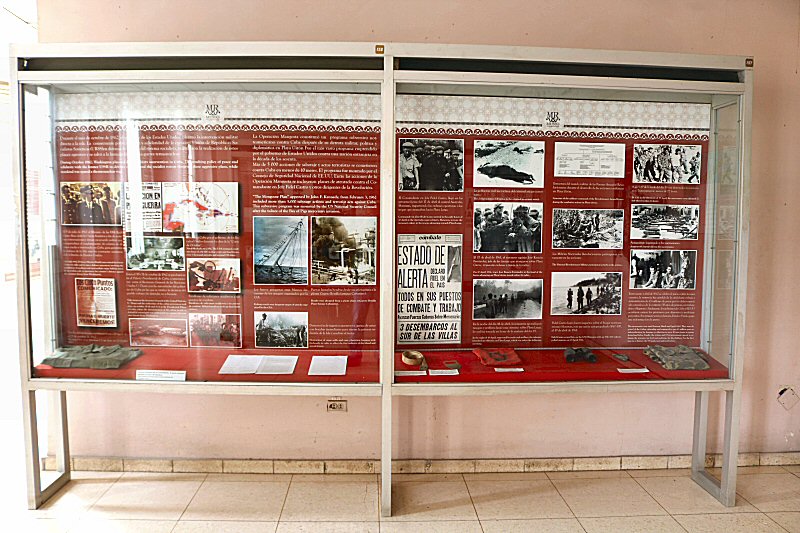The first floor contains the Despacho Presidencial (Presidential Office), the Salón de los Espejos (Hall of Mirrors), the Salón Dorado (Golden Hall), the Salón del Consejo de Ministros (Hall of the Council of Ministers), the chapel and some rooms, used as permanent exhibition rooms currently.
In front of the entryway to the presidential office there is the statue of the three pioneers of the Cuban revolution together. Fidel Castro is in the middle, Camilo Cienfuegos on the left and Ernesto Che Guevara on the right. The monumental sculptural set, called Trilogía de la Revólucion Cubana, is the replica of the work of the Mexican sculptor Oscar Ramirez Quintero. It was brought from Mexico in 2010.
On the wall at the right side of the trilogy there is the oil painting with the title Pasajes de la Historia (Passages of the History) by the Cuban painter Juan Emilio Hernández Giró.
In the
Presidential Office the original empire style furniture is good preserved. Most of the furniture is from 1940s. Previously it was very simple decorated, not with so many artistic details that can be seen
currently in the room. The cabinet, made of Cuban mahogany, was used to store the important files, but also the liquor set. The inkwell set, the card holder and the document holder are exhibited on the desk. Batista was making his own ink, so that nobody would be able to falsify his signature. The nearby typewriter was used by Batista himself, as he had begun his military career as a simple stenographer in 1921. The marble bust of José Martí behind the desk is the work of the Cuban sculptor Esteban Betancourt Diaz de Rada. The gold laminated phone that was presented to Batista by the US Ambassador Arthur Gardner during an award ceremony in 1957, was among the pieces that were exhibited in this room in former years. In this room Fidel Castro was sworn in in 1959. Opposite to the desk of the president, at both sides of the door that gives direct access to the Salón de los Espejos
(Hall of Mirrors), you will see the portraits of Tomás Estrada Palma (on the
right) and Carlos Manuel de Céspedes (on the left), painted in oil by Esteban Valderrama Peña. In 1959 Fidel Castro was assigned Prime Minister and Che Guevara became the President of the National Bank in this office. The office hosted also prestigious figures, such as Winston Churchill and Richard Nixon, among others.
Just in front of the entrance door of the presidential office there is a door that opens to an inner staircase. It was used by Fulgencia Batista during the assault on the Presidential Palace in 1957. He had fled through this door to the 4th floor where the headquarter of the guards of the palace was, before the rebels could reach his office. The rebels had practiced on the plan of the Presidential Palace, but they were not aware of the existence of any secret door. They had entered into the building through the south door that was always left open on the contrary to the main door that was kept open only when the palace was waiting for important personalities.
The most flamboyant place of the building is the
Salón de los Espejos with the excellent painting at the ceiling. This 22-meters long canvas with the title El Triunfo de la Republica (The Triumph of the Republic) is the work of
Armando García Menocal. The hall, inspired by
La Galerie des Glaces
of the Palace of Versailles in Paris, was designed as the ballroom. The opposing walls are covered by giant mirrors that have the effect of enlarging the hall. Two oil paintings,
painted by Antonio Rodríguez Morey, are adorning the walls. On the right canvas with the title La Fuerza (the Force) you will see a soldier killing his enemies, and on the left canvas with the name El Derecho (the Justice), three women are illustrated with statute books in their hands. The walls are ornamented with golden embossments and the Phrygian caps.
In this hall the dignitaries and the personalities that were visiting Cuba, were entertained, and the accredited ambassadors presented their credentials to the President here. In front of the Salón de los Espejos there is a wide terrace from that you can see the Parque Plaza 13 de Marzo and the surrounding up to the sea.
The marble busts of José Martí, Simón Bolívar and Abraham Limcoln stand on the hallway around the staircase.
One of the most exclusive sites of the building is the Salón Dorado, decorated by yellow marble with gold embossments on the walls in Louis VI style. This hall was used for official banquets. Three plafonds, 4 meters long in each, are adorning the ceiling. They are oil canvas, adhered to the wall with paste. They have the title Las Artes (the Arts), and they are the work of Leopoldo Romaňach Guillén, completed shortly before the inauguration of the Presidential Palace in 1920.
In the Salón del Consejo de Ministros the original
furniture that consist of a long wooden table and wooden
chairs, is preserved. At the background the wall is covered
by an oil painting that represents the Assembly of Guáimaro,
that had approved the first Constitution of Cuba in
Arms and the national symbols on April 10, 1989. The oil
canvas is the work of the Cuban painter
Juan
Emilio Hernández Giró that completed it in 1944. From 1920
to 1940 the Council of the Ministers held its meetings in
the office of the president. From 1941 on, this room became
the head office of the Council of Ministers of the Cuban
Republic. After 1959, this room was dedicated to
the Council of Ministers of the Revolutionary Government
until 1965. Its sessions on Tuesday and Friday were presided
by the personalities, such as Fidel Castro, Ernesto Che
Guevara, Camilo Cienfuegos and Raúl Castro. On the walls,
there are some panels with photos that give information
about some important meetings of the council in the past.
The first panel reflects the atmosphere of the
first year after the triumph, when the main socio-economic
transformations took place in the country, such as the
assumption of the leadership of the Revolutionary Armed
Forces by Raúl Castro in 1959 and the appointment of Ernesto
Che Guevara as the President of Banco Nacional de Cuba by
the Council of the Ministers in 1959. The next panel gives
information about the culminated conflict between the Prime
minister Fidel Castro and the President Manuel Urrutia Lleó
that entered into contradiction with Fidel Castro because of
the marked opposition of the former to the radical course of
the Cuban Revolution, and subsequently, resigned after a lot
of protest and pressure in 1959. The next panels are
reserved to “some aggressions carried out by the US against
Cuba”, such as the “Cage” operation in Las Villas province,
the failed invasion of Playa Girón, the marine blockade, the
Mongoose plan of the US, the October crisis etc. All these
events are narrated in detail and documented by photos and
maps. In the last panels the establishment of the first
Central Committee of the Communist Party, and the adoption
of the Constitution of 1976, and the internationalist
cooperation worldwide are given shortly.
In the small chapel the replica of the former altar
and the Tiffany chandelier are all what you can see.


